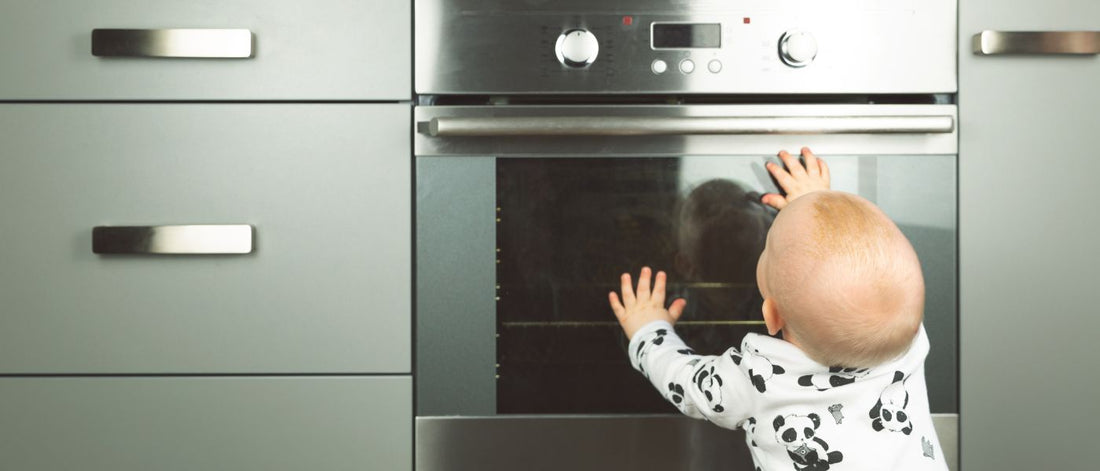When you have your first baby you may wonder why everyone panics to baby proof their homes when this little newborn can’t even lift their head up. Then your baby finally learns to roll and you think to yourself that you have plenty of time to put the cabinet locks on, and then with the blink of an eye they’re drinking out of the toilet, eating the dirt from the potted plants, and climbing up the bookcase. The best defense to keep your child safe is to be proactive.
Do not wait to find out if your child is curious about what is inside your cleaning cabinets, or to find out just how permanent nail polish is on your couch. Start thinking like a toddler (only for this exercise, not always because our world would be a tantrum mess [not that the world reads my blogs]). What is new, mysterious, exciting, shiny, or colorful? If it is dangerous, keep it far far out of reach of your baby/toddler.
I found an amazing checklist broken down by room on The Stair Barrier’s website. Here is a similar list of my own focusing on the main safety measures in general.
Install Safety Gates
- Safety gates are an essential part of childproofing your home, particularly for stairs and rooms that are off limits. There are gates for all types of stairwells whether you have walls on both sides or a banister.
Secure Furniture and Appliances
- Toddlers often climb and explore their surroundings, so it’s important to secure furniture and appliances such as bookcases, dressers, and televisions to the wall to prevent them from falling on the child. Ikea advertises this quite frequently and ensures that their furniture comes with anchors for the wall. Not all furniture comes with this especially if it is hand me downs or second hand.
Keep Small Items Out of Reach
- Small items such as coins, buttons, food items, and toys with small parts can pose a choking hazard to babies and toddlers. My pediatrician says anything small enough to fit through a toilet paper roll is too small. Keep these small items out of reach, and ensure toys are age-appropriate. Real scary items are deflated balloons because they are hard to do the Heimlich as a life saving method if the child does swallow them.
Cover Electrical Outlets
- Electrical outlets can be a tempting target for little fingers. Cover electrical outlets with outlet covers to prevent electrocution. Also, keep any electrical cords out of reach as baby and toddlers tend to put everything in their mouth--especially when they are teething and are wanting to chew on something. You can get plug covers at almost any store, including your local grocery store.
Lock Up Cleaning Supplies and Medications
- Keep all cleaning supplies and medications out of reach and locked away from young children of any age. These can be found at almost any store as well, and if your cabinets have door knobs you could even tie the doors together with a string or dish towel.
Use Cordless Window Coverings
- Window cords can pose a strangulation hazard to babies and toddlers. They actually do not sell corded blinds anymore because of this reason. Use cordless window coverings to eliminate this risk. Home Depot or Lowes has affordable, easy-to-install options that they will cut down to size for you.
Install Smoke Detectors and Carbon Monoxide Detectors
- These are hopefully already installed in your home, but if not smoke detectors and carbon monoxide detectors should be in every room of your home.
Create a Safe Sleeping Environment
- Ensure your baby’s sleeping environment is safe by using a firm, flat mattress in a crib with no soft bedding or pillows. The Baby Cubby has amazing safe sleeping options for your babies.
Keep Hot Liquids and Foods Out of Reach
- Hot liquids and foods can cause burns to your babies so keep them out of reach and only use placemats or tablecloths that cannot be easily pulled off onto your child. Often it is suggested to turn down your water heater temperature to prevent any accidental burns when washing hands or using the bath.
Be Vigilant
- Finally, always be vigilant. Babies and toddlers can move quickly and accidents happen in a split second. Keep an eye on them and be ready to intervene when necessary.
Navigating the different milestones of your baby can be daunting and scary, but learning about how to keep your babies safe at each stage can help you to feel more confident and keep your baby as safe as possible.
For more baby safety tips go to babycubby.com.







1 comment
Excellent information! Wish I had Read this before my daughter started running around. It really is a blink of an eye!